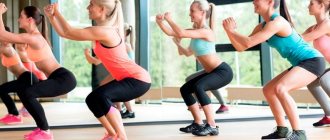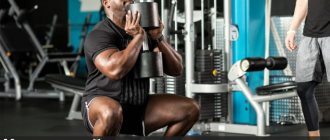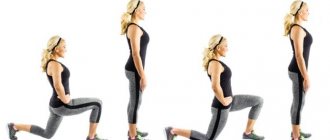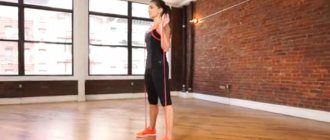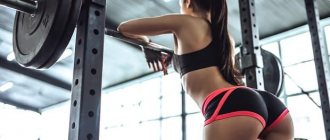I want to say right away that in powerlifting, squat and bench training are very similar in terms of training principles, unlike deadlift training. Because in deadlift training, slightly different laws apply and what works in the squat and bench press, as a rule, does not work in the deadlift.
The only difference in the squat and bench press is that the squat requires a slightly smaller volume, since the barbell press uses smaller muscles and therefore needs less time to recover.
WANT TO SQUAT MORE? SQUAT MORE!
The Cowboy Method grew out of the Texas Method. I originally called it the Big Texas Method, but the Cowboy Method sounds better and the Big Texas Method makes me think of the cinnamon rolls you buy in the vending machine.
The origins of the Cowboy Method were found in Glenn Pendlay's Texas Method squat program. The Texas Pendley Method involves 3 workouts per week with high volume on Mondays, low volume on Wednesdays and high reps on Fridays or Saturdays; Overall, this is a great program that will lead you to excellent results.
Like most people reading this, you need more, you need more size, more muscle, more practice with the exercises, and the cowboy method will provide it all. If you are a beginner or intermediate lifter, you need more VOLUME, if you are an advanced lifter, a high volume phase can help you build muscle, give you a break from heavy weights and the opportunity to train in a new way.
Let's digress for one minute on a very important point. YOU MUST BE HONEST WITH YOURSELF ABOUT YOUR LEVEL. I squatted 800 pounds at my first powerlifting meet and considered my performance to be average. The lifter is an average person with advanced talent. Before that, I trained for 12 years and only felt perspective at that moment.
Most beginner and intermediate lifters need more volume for two main reasons:
- they are ineffective and under stimulated by low volume/high intensity compared to advanced lifters;
- they need to practice more to become more effective. If your sport is powerlifting, then the squat performed in competition is sports practice - don't lose sight of this fact.
The increased workload of the cowboy method will give you the opportunity to build muscle in your body, improving your squat technique and movement efficiency. And what is important for this, or any program, is that you become more confident by successfully lifting all the weights planned. The weights you don't lift don't make you stronger; the weights you lift make you stronger.
Set your weekly rep max and try to make small increases from week to week. This small amount of progress will lead to continued gains over time. Once you have established your target rep max, use the last week's results as a guide and make small increases to your target rep max (3-5 pounds) each week using the following equation:
(WEIGHT X REPS X 0.033) + WEIGHT = ESTIMATED MAXIMUM
Remember that an estimated max based on a higher rep range (6-10 reps) is less accurate than an estimated max based on a lower rep range. Rep max tends to be higher for women or lighter lifters.
Execution technique
1Gai.Ru (translation) / artofmanliness.com
- Once you've positioned the barbell and moved into a front rack, it's time to squat.
- Position. Place your feet slightly narrower than shoulder width, with your toes slightly turned out to the sides.
- Watch your elbows to keep your body upright. Unlike low bar squats, where you lean your torso slightly, you want your upper body to remain upright throughout the exercise. To do this, simply repeat to yourself that your elbows should “look” up. If you find yourself leaning forward slightly as you lift, remember that your elbows come up first.
- Another helpful signal is to look straight ahead.
- Take a deep breath and slowly lower yourself down, pushing your knees forward so that your pelvis is below parallel with the floor. Remember to keep your torso upright, always thinking about your elbows.
- Get up quickly. The eccentric portion of the squat should be fast. Push off!
- And don't choke yourself! The bar will be located quite close to the throat. Be careful not to let it put too much pressure on it, so as not to cut off the blood supply to the brain. Otherwise, it will lead to fainting and loss of consciousness. Not cool.
A WEEK OF COWBOY METHOD SQUTS LOOKS LIKE THIS:
- Monday - low intensity, high volume back squats
- Wednesday - front squats with medium intensity and medium volume
- Friday or Saturday - back squats for maximum reps (high intensity, low volume)
Be sure to apply maximum effort each time you lift the barbell to achieve the desired training effect.
Now let's discuss the parameters of this 13-week plan. If you are a less experienced lifter, you may want to hold off on the deload and test weeks. On Mondays, 10x5 means sets x reps. On Wednesdays, "55/60/65/70/75%x5" means 5 reps in each percentage range. On Fridays, before working up to your rep max, do as few warm-up sets as possible to prepare for your main set. Do warm-up sets of 5 reps or less, and if you need more warm-up sets, do them at a lower intensity. Women and weaker lifters should stick to a shorter rest range on Mondays.
Let's look at how to choose weights for rep maxes every Friday/Saturday. You should start from your target weight. As an example, let's look at how Joel Thompson, owner/head trainer of CrossFit Tustin, did it. Joel began Cowboy Method training with a squat best of 305 pounds and a target weight of 355 pounds. Joel is taller and leaner (6'3", 200 lbs) and we know that in this case it is better to work in the higher rep range, so we decided to make it harder, so his 10RM is planned at 319 lbs, while While for a heavier lifter, the 10RM should be planned below his maximum.
INITIAL MAXIMUM - 305
- 10RM - 240×10, plan. Max. - 319
- 8RM - 255×8, plan. Max. - 322
- 5RM - 280×5, plan. Max. - 326
- 8RM - 265×8, plan. Max. - 335
- 5RM - 290×5, plan. Max. - 338
- 3RM - 310×3, plan. Max. - 340
- 5RM - 295×5, plan. Max. - 344
- 3RM - 320×3, plan. Max. - 352
- 2RM - 335×2, plan. Max. - 357
- 1RM - 355×1
Plie, sumo, curtsy: 12 types of squats to strengthen the muscles of the lower body
Squats are one of the most popular and versatile exercises for training.
They can be performed not only in the gym, but also at home, on vacation, and, in principle, in any convenient place. Squats do not require additional equipment - they can be done with your own weight, and if you want to increase the load, improvised means, for example, heavy books or water bottles, will do. There are a large number of variations of squats, and many of them strengthen not only the gluteal muscles, but also almost all the muscles of the lower body, as well as the abs. We talk about the most popular types of squats in our material. Why do different types of squats?
Doing the same thing for a long time will definitely get boring someday. Therefore, so that even your favorite activity does not become a burden, you need to add variety to it. The same rule works in sports. Doing the same type of squats day after day can eventually just get boring, and when something starts to get boring, many of us just stop doing it. To prevent this from happening, you can diversify your workouts.
Plus, different types of squats target different muscle groups, so incorporating alternative exercises into your fitness routine can help you achieve the best results in your quest for a toned figure.
Types of squats
1. Standard
This is a basic exercise and the most popular type of squat. If you master it, it will be easier for you to cope with all the others.
Stand straight with your feet shoulder-width apart, your feet parallel to each other. Start squatting without bringing your knees past your toes. In this case, the body weight must be shifted to the heels. Lower yourself until your thighs are parallel to the floor. To rise to the top, engage your glutes by squeezing them as you lift.
2. Sumo
This exercise works your inner thighs and glutes a little more than a standard squat. And all thanks to the positioning of the legs.
They need to be placed wider than your shoulders, and your toes should point to the sides. The body should be tilted slightly forward and the pelvis should be pulled back. Squat until parallel to the floor. When going up, do not straighten your knees all the way. Otherwise, you may injure your joints.
3. Plie
This type of squats is similar to the previous one, but still has some differences. The legs should be placed even wider, and the toes should be turned even further to the sides. The position will resemble a well-known ballet element, hence the name squat. Keep your back straight, tighten your abs and lower your pelvis down until your thighs are parallel to the floor. Hold this position for a couple of seconds and then rise up. As a bonus, you will work on stretching and strengthen your abdominal muscles.
4. Bulgarian lunges
This type of squats is aimed at working the quadriceps and gluteal muscles, as well as strengthening the knee joints and flexors.
Place one foot on a chair with your back to it. Leaning forward slightly, lower yourself onto the other leg until the first knee touches the floor. To rise up, place your weight on the heel of your foot on the floor and push off.
5. With jumping
By adding a cardio element like jumping jacks to standard squats, you will effectively work the muscles of your lower body, improve agility and coordination, and burn additional calories through aerobic activity.
Get into a standard squat position, squeeze your glutes, press through your heels, then transfer your weight to your feet and jump up off your toes.
6. "Curtsy"
This exercise actively works the inner thigh muscles, which are always much more difficult to pump.
Place your feet slightly wider than your shoulders and point your toes slightly to the sides. As you squat, shift your weight to one leg and step back into an oblique lunge with the other. Carefully monitor the knee of the supporting leg and do not move it beyond the toe. During each squat, alternate legs.
7. Malasana
Malasana is one of the most popular poses in yoga. It increases blood circulation in the pelvis, improves stretching of the thigh and groin muscles and works the core muscles.
From a standing position, raise your arms up, then lower yourself deeply, bending your knees. Place your elbows on your hips and press down on them, stretching them to the sides. Hold this position for a few seconds, continuing to press down on your hips.
8. With calf raises
This exercise strengthens the hip, knee and ankle joints, and also works the quadriceps, glutes and hamstrings.
Place your feet shoulder-width apart or wider, as in a sumo position. Slowly lower yourself down, placing your weight on your heels. Squeeze your buttocks and begin to rise, lifting your heels off the floor and standing on your toes.
9. With legs raised to the sides
These squats target the gluteus maximus, quadriceps, hamstrings, and core muscles.
Do standard squats, adding alternate leg swings to the side each time you go up. When abducting, try to hold your leg at the top a little and only then lower it down and squat.
10. Cossack squats
This exercise is often used by runners before a long race, but it will fit perfectly into a regular workout as it will help stretch and warm up the muscles.
Your legs should be spread quite wide. Slowly shift your body weight to one side, bending the hip and knee of the leg you are descending towards. Place your other leg on your heel and pull it towards the floor as low as possible. Then slowly rise to the starting position and lower yourself onto the other leg, doing the same thing.
11. Pistol
Let’s say right away that this type of squat is one of the most difficult, and beginners are unlikely to be able to master it right away. But at the same time, this exercise is extremely effective and not only works the leg muscles and stabilizers, but also develops coordination.
In a lighter version, you can perform it using a chair. Stand straight with support on one leg. Raise the other one above the floor. Sit down on the chair while maintaining your balance. When climbing up, leave your leg in weight.
In a difficult version, you should lower yourself to the floor, also leaning on one leg and straightening the other forward.
12. Spring
These squats are similar to standard squats, but thanks to the “spring” movement, the quads and glutes “burn” much faster. So this exercise is best included at the end of a workout to “finish off” the muscles.
Lower yourself down as you would for a standard squat. Pause at the bottom point and begin to spring up and down, maintaining a small amplitude. Do as many “springs” as you can, and then rise up to the starting position.
PLANNING YOUR SQUATS
| Monday | Wednesday | Friday |
| WEEK 1 | ||
| Squats - 60%, 10x5, rest 45-60 sec | Front squats – 55/60/65/70/75%x5 | Squats – work up to 10RM |
| WEEK 2 | ||
| Squats – 67.5%, 10x4, rest 75-90 sec | Front squats – 60/65/70/75/80%x3 | Squats – work up to 8RM |
| WEEK 3 | ||
| Squats – 75%, 10x3, rest 105-120 sec | Front squats–65x5, 70x4 75x3, 80x2, 85%x1+ | Squats – work up to 5RM |
| WEEK 4 (UNLOADING) | ||
| Squats – 60%, 5x3 | Front squats–60% 3x3 | Squats – release and hold 95% of target max for 10 seconds |
| WEEK 5 | ||
| Squats – 65%, 8x5, rest 60-75 sec | Front squats – 60/67.5/75/82.5%x4 | Squats – work up to 8RM |
| WEEK 6 | ||
| Squats – 72.5%, 8x4, rest 90-105 sec | Front squats – 65/72.5%x3, 80/87.5%x2 | Squats – work up to 5RM |
| WEEK 7 | ||
| Squats – 80%, 8x3, rest 120-135 sec | Front squats–70x4, 77.5x3, 85x2, 92.5%x1+ | Squats – work up to 3RM |
| WEEK 8 (UNLOADING) | ||
| Squats – 65%, 5x3 | Front squats–65% 3x3 | Squats – release and hold 100% of target max for 10 seconds |
| WEEK 9 | ||
| Squats – 70%, 5x5, rest 75-90 sec | Front squats – 65/75/85%x3 | Squats – work up to 5RM |
| WEEK 10 | ||
| Squats – 77.5%, 5x4, rest 105-120 sec | Front squats – 70/80/90%x2 | Squats – work up to 3RM |
| WEEK 11 | ||
| Squats – 85%, 5x3, rest 135-150 sec | Front squats–75x3, 85x2, 95%x1+ | Squats – work up to 2RM |
| WEEK 12 (UNLOADING) | ||
| Squats – 70%, 5x3 | Front squats–70%, 3x3 | Squats – release and hold 105% of target max for 10 seconds |
| WEEK 13 (PASSING) | ||
| Front squats – up to 1RM | Rest | Squats – up to 1RM |
Sometimes the weights feel light, sometimes heavy, create your plan and work. Since rep maxes are repeated (8RM, 5RM, 3RM), adding even 5 pounds is progress and can be described as “it’s a marathon, not a sprint.” I would recommend not using the belt unless necessary, try not to wear the belt on Mondays and all but the main sets on Wednesdays, and in the first weeks on Fridays/Saturdays for rep maxes.
As for the accessory, if you are using this program for powerlifting, 2-5 sets of exercises for quads with an emphasis on single leg exercises (step-ups, lunges, split squats), hamstrings/lumbar exercises (GHR, reverse hyperextensions, good mornings) , bending) and the press will be enough. If you want to use this program for CrossFit, keep reading.
OTHER LIFTS
Now that we've talked about squats, what about other lifts? Before we start talking about the bench press and deadlift, let me discuss one issue.
Can the cowboy method be applied to the bench press? Certainly! Don't press and squat at the same time, although if the squat is strong and the press is lagging, then give it a chance. Use the same percentages, but do bench presses instead of squats and overhead presses instead of front squats.
Can you apply the cowboy method to deadlifts? Maybe. Personally I wouldn't, 3 deadlifts a week can be fatal, but if you manage it you can get good at it. I would do high volume work (Monday) from low stands in the competition position, medium volume work (Wednesday) from medium stands in the opposite position to the competition position, and heavy work in the competition position from the floor.
Considering that we're doing the bench press in conjunction with the squat as our primary lift, there are 2 different ways to incorporate the bench press into the plan. These will depend on your schedule and your bench press ability.
The first route is for a weaker bencher who needs higher volume. In general, this mirrors the reverse volume squat program. So we do a heavy bench press on Monday, a medium volume overhead press on Wednesday, and a high volume bench press on Friday.
A complete training cycle for the bench press would look like this...
First about depth
Range of motion can be divided into several categories:
Full squat
Here we include all options from the deepest weightlifter (with maximum bending of the legs) to the lifter (the hip joint is below the knee or the top of the thigh is just below parallel).
Half squat
The top of the thigh is parallel to the floor, the bend angle at the knees is about 80-85 degrees.
Partial Squat
In this group there are variations when the knees bend at an angle from 90 to 110 degrees.
Depth and hypertrophy
In this regard, a full squat is slightly more effective than a half squat and much more effective than a partial squat. The fact is that one of the main growth stimuli is microtrauma of the muscle ( This is not true - Tibado did not study at the Association of Fitness Professionals and does not follow the current state of science, microtears and muscle injuries are not a factor in their growth at all - Zozhnik’s note). It is caused by stretching of the muscle fiber under load/tension; The greater the range of motion, the more microtrauma.
But the half-squat also stimulates hypertrophy, so if for some reason you cannot sit below parallel, it’s okay, you’ll still get pumped up.
Depth and strength
Strength can be developed in all variations, but, naturally, you will be stronger in what you practice. For example, if you are doing weightlifting, then focus on a full, weightlifting squat.
But not everyone needs this. For example, a half or even partial squat is enough for sprinters and shot putters.
So now there are 10 squat variations.
PLANNING THE BENCH PRESS
| Monday | Wednesday | Friday |
| WEEK 1 | ||
| Bench press – work up to 10RM | Overhead press – 55/65/75%x5 | Bench press - 60%, 5x10 |
| WEEK 2 | ||
| Bench press – work up to 8RM | Overhead press – 60/70/80%x3 | Bench press – 67.5%, 5x8 |
| WEEK 3 | ||
| Bench press – work up to 5RM | Overhead press – 65x5, 75x3, 85%x1 | Bench press – 75%, 5x6 |
| WEEK 4 (UNLOADING) | ||
| Bench press – 60%, 3x5 | Overhead press – 60%, 3x3 | Bench press – 65%, 3x5 |
| WEEK 5 | ||
| Bench press – work up to 8RM | Overhead press–60/70/80%x4 | Bench press - 65%, 4x8 |
| WEEK 6 | ||
| Bench press – work up to 5RM | Overhead press–65/75/85%x2 | Bench press – 72.5%, 4x6 |
| WEEK 7 | ||
| Bench press – work up to 5RM | Bench press – work up to 5RM | Bench press – work up to 5RM |
| WEEK 8 (UNLOADING) | ||
| Bench press – 65%, 3x5 | Overhead press – 65%, 3x3 | Bench press – 65%, 3x5 |
| WEEK 9 | ||
| Bench press – work up to 5RM | Overhead press–65/75/85%x3 | Bench press – 70%, 3x5 |
| WEEK 10 | ||
| Bench press – work up to 3RM | Overhead press–70/80/90%x2 | Bench press – 77.5%, 3x4 |
| WEEK 11 | ||
| Bench press – work up to 2RM | Overhead press–75x3, 85x2, 95%x1+ | Bench press – 85%, 3x3 |
| WEEK 12 (UNLOADING) | ||
| Bench press – 70%, 3x5 | Overhead press – 70%, 3x3 | Bench press – 70%, 3x5 |
| WEEK 13 (PASSING) | ||
| Bench press – up to 1RM | Rest | Military press – up to 1RM |
The second way to train the bench press is for higher level lifters who can handle heavier weights and need more rest time. For this variation, I suggest training the bench on Tuesday using a basic variation of Brandon Lilly's Cube method. If you choose this option, I recommend doing a back/bodybuilding day on Saturdays, assuming you squat on Fridays or switch those days.
Training deadlifts using the cowboy method is simple. Due to the very high training volume of squats, deadlifts are trained once a week, on Wednesdays after front squats, following a Cube method style frequency. Alternate between speed, repetition and heavy work each week.
Using this method, try the following program...


